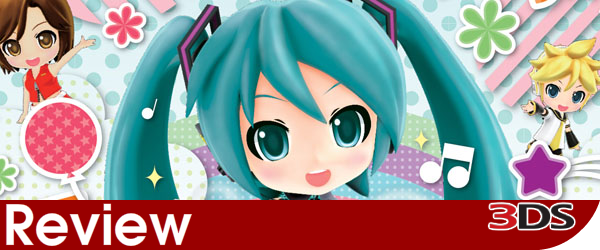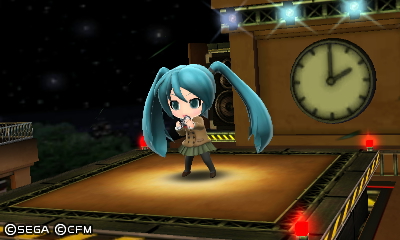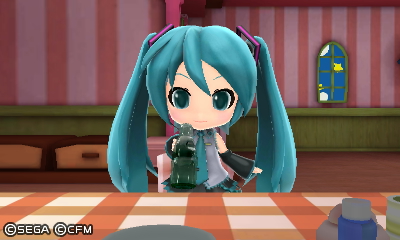

Developer/Publisher: Sega
Release Date: September 8th, 2015
Price: $39.99
Hatsune Miku started out as, and technically still is, a voice synthesizer program, but for the best part of her life she’s been looked upon as the world’s most famous virtual singer. She and her fellow Vocaloids have way too many songs to count, but every once in a while a bunch of the more famous ones get compiled into a rhythm game by Sega. The latest such release is Hatsune Miku: Project Mirai DX for the 3DS.
Project Mirai DX has 48 songs; a music video plays out on the upper screen while you follow the on-screen prompts to keep in time with the music. There are two play modes: Tap Mode and Button Mode. In Tap Mode, you use the touchscreen to tap and hold panels in time with the prompts on the upper screen. Some prompts also require you to slide and spin the stylus to get a bonus added to your score. The Easy difficulty has only one touchscreen panel, Normal has two and Hard mode – which is unlocked by beating the song on Normal – has three. Tap Mode is the more challenging of the two play modes; it’s easy to tap the wrong panel by mistake and ruin your combo. Button Mode is instantly familiar for anyone who’s played the Project Diva games: you simply press and, if prompted, hold the buttons in time with the on-screen prompts which slide through an on-screen rail, sometimes tracing out patterns that fit in with the song’s theme. Overall, the game is rather easy, even if keeping your combo going and hitting the special prompts that disappear if you mess up has a certain intensity to it.
The music is pretty varied and while everyone will find one or two songs to hate (I’m sorry, OSTER Project, but ‘PianoxFortexScandal’ was one of them for me), most of them are enjoyable; several are memorable enough to take their place among your favourite Vocaloid songs. There are several old favourites like ‘World is Mine,’ ‘Romeo and Cinderella,’ and ‘Servant of Evil.’ A couple of the first few songs’ music videos boast great dance animations but don’t really do much because of the empty surroundings, but almost all of the rest have great videos that complement the songs really well.

Mousou Sketch has one of the best music videos in the game.
You can choose between Miku, Rin, Len, Luka, Meiko and Kaito as your main Vocaloid; Gumi only appears in songs and stops by to give you tips. It’s primarily a rhythm game, but Project Mirai DX places a heavy emphasis on interacting with your Vocaloid in a pet sim-ish way. You can call to them, talk to them using the microphone (they don’t actually reply, but make gestures and their expressions vary according to what you say), feed them, give them an allowance to spend on themselves, and play a board game with them. You can also buy outfits for your Vocaloids to wear while hanging out with you, as well as rent a penthouse or villa with them.
One of the main differences Project Mirai has from its sister series Project Diva is that the Vocaloids in Project Mirai are chibis – super-deformed heads, short legs and all. This cute aesthetic enhances the game’s child-friendly factor, although the game is aimed at all fans (we’d have gone ‘kawaii’ anyway). As for the character models, they’re a marvel. Not since Resident Evil: Revelations have we seen such smooth character models on the 3DS. The visuals in this game look good during Hang Out mode; they’re mind-blowing while playing through songs.

Do the Dew.
There’s an extra mini-game, Puyo Puyo 39!, included which supports local multiplayer. Apart from that, you can design your own dance routines for the songs, make your own simple tunes using a variety of synthesized instruments, and there’s AR card support. You can change the singer in a couple of songs after playing through them all, including ‘1925,’ which all Vocaloids except Gumi sing.
The only department which leaves something to be desired in Project Mirai DX is the presentation. It’s serviceable, but not a complete breeze to navigate through. Despite it being the main attraction, the Rhythm Game option is pushed off to one side like a plant cell nucleus, with Hang Out Mode being the vacuole. If you’re the sort of person who doesn’t mess around with what they don’t know about or relied solely on the touchscreen to browse the menus, you’d probably never find the Create-a-Tune option; it isn’t labelled.The presentation’s shortcomings don’t detract from the gaming experience, but you might wish that the songs had been labelled by their generally accepted English titles instead of Romaji.
Project Mirai DX is an excellent game. Its looks great, sounds great and plays great. It won’t do anything for people who aren’t fans of the Vocaloid phenomenon, but for its target audience, it’s a must-buy.
Overall Score: 9/10